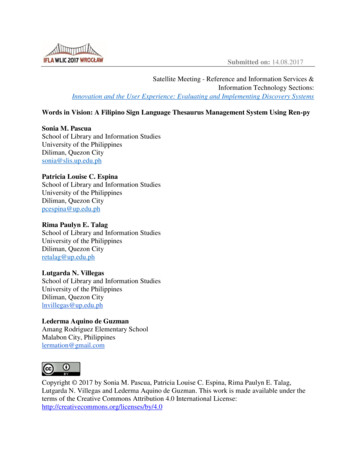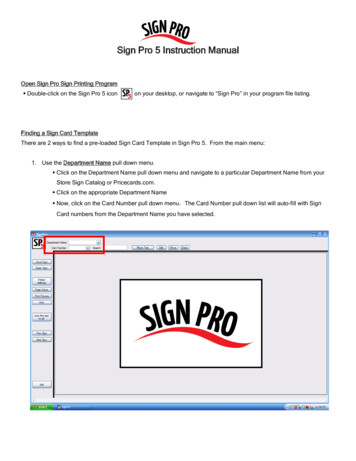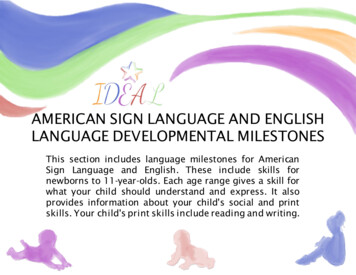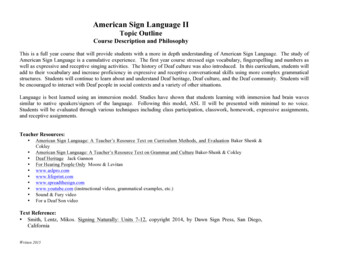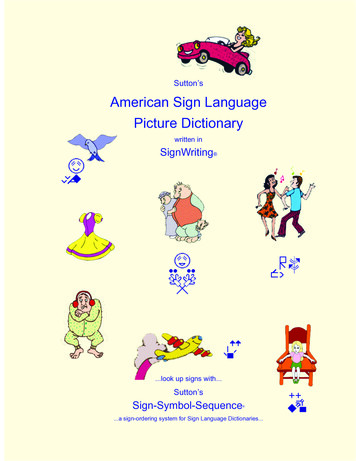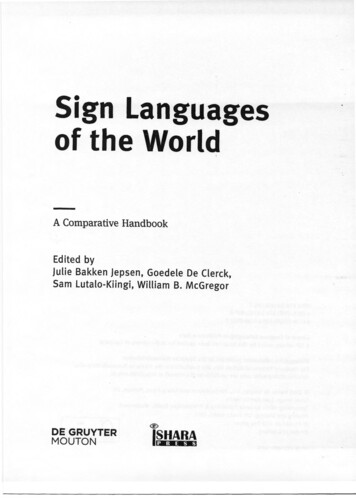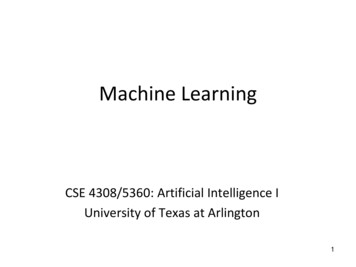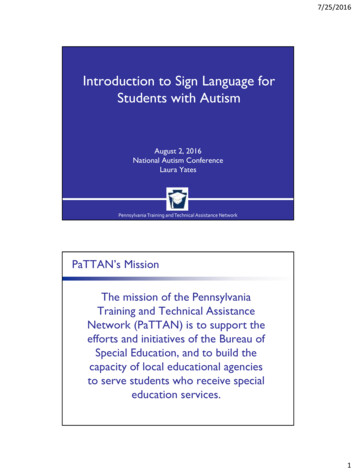
Transcription
7/25/2016Introduction to Sign Language forStudents with AutismAugust 2, 2016National Autism ConferenceLaura YatesPennsylvania Training and Technical Assistance NetworkPaTTAN’s MissionThe mission of the PennsylvaniaTraining and Technical AssistanceNetwork (PaTTAN) is to support theefforts and initiatives of the Bureau ofSpecial Education, and to build thecapacity of local educational agenciesto serve students who receive specialeducation services.1
7/25/2016Presentation Outline Students with AutismResponse FormVerbal BehaviorAbout Sign LanguageBenefits of SignBasics of SignHow to Teach sign (mands, tacts, intraverbals)Goal of Presentation Review Core Deficits of Autism– Socialization– Communication– Flexibility How do we know what works with thispopulation and how do we teachcommunication?2
7/25/2016Difficulty of Speech An estimated half of all childrenwith autism are non-vocal orhave difficulty acquiring speech(Scott, Clark, Brady, 2000).Evidence-Based Practices What does evidenced-based mean? How do we know what they are or where tofind them? What are the evidence-based practices? Why does it really matter?3
7/25/2016Language Language is complex Behavior interventions make complex aspects ofhuman functioning simple Primary choice for communicating with others isvocal speech What if speech doesn’t develop typically? What are the other options for communicating?Alternatives to Spoken Language GesturingUsing picturesSigningWritingTypingAugmentative devices with various accessmodes/voice generation4
7/25/2016The Form of Language People communicate with language behaviorsThis language can look differentWe call this the form of languageThe avenue in which a person communicatestheir wants and needs to another person iscalled their response form Response form is the general shape andphysical characteristics of the behaviorsthrough which one communicatesResponse FormTypes of response forms includevocalization, sign language, pictureexchange, writing, and variousaugmentative devices.5
7/25/2016Vocal/Verbal Response FormFormFunction Vocal-Verbal Verbal (Saying Water) Nonvocal-Verbal Verbal (Signing Water, handing over apicture of water, writing) Vocal-Nonverbal Non-Verbal (non-social vocal noisessuch as coughing) Non-VocalNonverbal Non Verbal (crossing legs)Response Form When selecting response form, a goodrule of thumb is always consider vocalfirst. Why?– humans are evolved to speak– our vocal apparatus is always with us (portability)– our culture shapes up vocal verbal behavior6
7/25/2016Response Form “Categories”Jack Michael (1985) was the first person tomake a clear distinction between two kinds ofverbal behavior. Stimulus Selection-Based Topography-BasedTopography-Based with RequestingSpeakingSigningWriting The motor movements are different Each word “looks” and “feels” different7
7/25/2016Selection-Based with RequestingPicture Exchange SystemsVocal Output Devices The motor movements are the same While this may seem simpler, there areadded complexities (scanning, discriminating)Analysis Tells Us Signing and talking are quite similar Selection-based systems share fewcharacteristics with speech8
7/25/2016Choosing a Response FormWhere do we start?Use a language assessment to help selecta response form.Decisions Based on Data What skills does the student have?How efficient are the responses?How easy are the skills to teach & acquire?How easily will the response form lead toindependent responses? Implications for developing a full range ofverbal responses and eventually complexbehavior Portability9
7/25/2016Response Form Consider vocal first! If vocalizations are unintelligible to the naive listener,vocal is not a functional response form. If weak echoic, consider sign language.––––PortabilityHands are always with usTopographical correlation an option for teaching vocalsFull range of verbal function If weak motor skills or attempts to teach sign fail, trypicture exchange or augmentative devices.Verbal Behavior B.F. Skinner in 1957 The meaning of a word is found in it’sfunction Teaching communication skills across theverbal operants VB is behavior mediated by other people Verbal behavior does not have to be spoken10
7/25/2016Verbal Behavior vs. Nonverbal Behavior“Verbal Behavior is behavior that has been reinforcedthrough the mediation of other persons”Verbal BehaviorWant juice------Say juice-----Person deliversSign WaterPoint To WaterExchange a PictureWrite WaterNon Verbal BehaviorWant juice-----Walk to refrigerator------Get juiceVerbal MandMotivative Operation(wants ball)Verbal behavior(says/signs “ball”)Direct reinforcement(gets ball)TactSensory Stimuli(sees or smells ball)Verbal behavior(says/signs “ball”)Non-specificreinforcement(gets praised, forinstance)IntraverbalVerbal stimulus(someone says “Whatdo you play with?”)Verbal behavior(says/signs “ball”)Non-specificreinforcement(gets praised, forinstance)EchoicVerbal Stimulus(someone says “ball”)Verbal behavior:repeats all or part ofantecedent(says “ball”)Non-specificreinforcement(gets praised, forinstance)11
7/25/2016Other Relevant ive(ListenerResponding)Verbal stimulus(someone says “touchball”)*Non-verbal behavior(child touches ball)Non-specific reinforcement(gets praised, for instance)*in this case the cookie mustalso be present: all receptivediscriminations involve 2SDsImitationPoint to pointcorrespondencea.k.a. MimeticNon-verbal behavior(person performs anaction, etc.)Non-verbal behaviorwith point to pointcorrespondence(person imitates sameaction)Non-specific reinforcement(example: praise; ‘you’reright!’, ‘’great job!’ highfive, pat on back, etc.)Match to sampleNon-verbal behavior(presentation ofstimuli)Non-verbal behavior (inpresence of onestimuli, a secondstimuli is selected withshared properties)Non-specific reinforcement(example: praise; ‘you’reright!’, ‘’great job!’ highfive, pat on back, etc.)12
7/25/2016Verbal Operants VideoSign Language Different kinds– Signed English– American Sign Language– Pidgen Sign Deaf community Is an established and true language: cancommunicate a full range of functions andcomplexity Martha’s vineyard culture in the 19thcentury Every country has a different sign language. Itis not exact signed English, I think of a lot of it13
7/25/2016ASL“A complete, complex language that employssigns made by moving the hands combined withfacial expressions and postures of the body.”–National Institute on Deafness and Other Communication DisordersWhere does it fit? Back to communication as a core deficitof autism Making complex behavior simple Observable behavior How do we teach and prompt skills14
7/25/2016Benefits Sign is one tool of many that allows teaching towardsthe core deficits for students who are not vocal1.2.3.4.Iconic repertoire built-inScanning and discrimination steps not necessaryFree from environmental supportCan be prompted through various methods (imitation,physical and intraverbal: “sign ‘ball’”)5. Portable (our hands are always with us)6. Free7. More conversationalSign Leading to Speaking? “The available body of research on manualsign and gestures for children with autismreveals strong intervention effectivenessscores for symbol acquisition and production,as well as related outcomes such as speechcomprehension and speech production. Theseresults suggest that the use of signing gesturesis a very effective communication option forchildren with autism.” (Schlosser & Wendt, p. 370)15
7/25/2016Only One Study by Anderson in 2002. Participants were found to prefer one response form overthe other, but their choices were not attributed to any singlefactor. Participants using the PECS– Faster acquisition– Better generalization to novel items Participants using sign language– Higher levels of initiation– Higher levels of eye-contact– Higher levels of vocalizationsConcerns with Sign Need competent audience Staff need to know how to teach signs,prompt, and fade prompts16
7/25/201617
7/25/2016Potter, Huber, & Michael (1997) College-aged students Talk-aloud experiment Asked to complete topography-based andselection-based tasksLET’S TRY THIS!Topography-based system proved less complexSequence of Language Acquisition Mands and tacts emerge as single operants(kids with limited language repertoire are firsttaught single words-but later combine) Initial use of multiple words includes usingmultiple known components (as opposed tofull phrases) Intraverbal skills not present until later in childdevelopment18
7/25/2016Initial Concerns Initially concern isn’t teaching grammar or signrelations It IS IN teaching a broad mand and tactrepertoire It is critical to teach a broad range of languagethat will be fairly easy and efficient for thechild to use and control their environmentInitial Signs to Target Begin teaching sign in the mand frame Choose signs that don’t resemble each other!(i.e., chocolate, church, computer, cup) AVOID generalized and broad signs like more,help, eat/food, drink/thirsty, sick AVOID phrases like “I want” or “I need” AVOID manners like please, thank you, andsorry19
7/25/2016Classifier Examples Basic hand shapes that make up most signsOften used to show relation, tell storiesCL:B something flatCL:4 linesCL:1 personCL:F small round thingsCL:3 vehicles5 Signing BasicsHandshapeOrientationLocation – signing spaceMovement(Facial Expression)20
7/25/2016Location rial on Signing Are they grounded or “air borne”Single handed or two handedDynamic or staticSingle step or multiple movementsRepetative movementsLocation in space, within view (cheese/puzzle, eat/drink, think/forget)Variations of the same signFingerspelling“Classifiers”No articles, pronouns, verb tenses (at this point)(puzzle, airplane)(alone, follow)(stand, walk)(mom, ketchup)(ball, popcorn, up)(room, kitchen, office)21
7/25/2016How Perfect Should they be? Want the best production they can make At first, to develop a broad repertoire, weaccept easier “baby signs” Work towards the adult form Just like vocalizations – don’t expectperfection. We shape. When I present signs, I’ll suggest ways theycan be made in simpler form You’ll want to shape to adult formFor “Baby” or Adaptive Signs 22
7/25/2016Teaching Sign Only have to be one sign ahead of studentTeach others (family, friends) via “sign book”Show on back of cardsWall chartsWhy do we begin in the mand frame?Just a Note Most of our students with autism are NOTDEAF. TALK TO THEM! BE VOCAL! We want them to use sign as a speaker (not alistener) Model signs you want them to use, but don’trequire them to respond to signs23
7/25/2016Fingerspelling Why important? Many words don’t have signs– Proper names, cities, books, etc. Many signs are sharpened by use of abc cue Teach ABCSBack to the Operants!A common term for a MAND is aREQUESTA common term for a TACT is aLABEL24
7/25/2016Mand TrainingTeaching students to make requests is acentral focus of teaching effectivecommunication skills Mands benefit the speaker Mand training relies on the use of the student’s interest andmotivation Mand training is clearly a functional skill: it’s practical! Mand skills develop early in child development and shouldnaturally be a part of early language training Motivation leads to increased likelihood of behavior!The Mand Saying something because you want it (antecedentis motivation) Result of behavior is getting what you ask for ABC Analysis- want it, say it, get it A common term for a mand is a request You can mand using different response forms– Possible concerns manding using different methods Types of mands: manding for items, actions,activities, missing items, removal of aversive stimuli,attention, information, etc.25
7/25/2016Teaching a Signed Mand VideoTeaching a Signed Mand Check for motivation by holding out item. If student reaches for item: Sign word as you say the word. If student models sign, reinforce as you say theword again, or: Provide full physical prompt as you say the word again followed by delivery ofreinforcement while saying word for the 3rd time Once student has practiced the correct mand several times begin tofade your prompt:– Say word, model sign and wait for student to repeat responseand deliver reinforcer while saying word, or:– Say and sign word, prompt and say word, then immediately fadeto a partial physical prompt wait for student to emit mand anddeliver reinforcer on the more independent response whilesaying the word again. Fade out prompt until the only antecedents controlling the mand arethe motivation and the presence of the item. Once mand is mastered with item present, move target to“spontaneous” mand program (item not present.)26
7/25/2016Teaching Sign in the Mand Frame Procedures for teaching signed mands– Pair– Establish Motivating Operation– Model If student imitates, deliver reinforcement! (& say) If no sign, provide physical prompt on 3rd attempt anddeliver reinforcement (& say)– 2 Types of Prompts Physical versus imitationTeaching a Signed Mand Video27
7/25/2016Imitation Prompts Imitation programs––––Teach the child to imitate – I do- you doGeneral larger motion signsTowards fine motor movementsTeaching sign responses in imitation before theyare used as functional operants (mands or tacts)Physical prompting When student doesn’t have imitationrepertoire Shaping process Use of least intrusive physical prompts Dynamic responsiveness to students behavior Student gets the “feel”28
7/25/2016Choosing a Prompt Why imitation is a superior prompt tophysical– Intrusiveness– Model is more accurate presentation of adultform– Physical prompts don’t allow the child to accessfeedback on accuracy or response emission– Child may learn that reinforcement is contingenton extending their hands: Zombie Hands!Beware of Zombie Hands Person moves child’s hands FOR them Failure to appropriately fade physical prompts Child learns1. Reach hands out2. Hands get manipulated3. I get reinforcement Results child approaches adults and sticks outhands (zombie hands) The same thing gets shaped up if you allow pointingto serve as a generalized mand29
7/25/2016Deliver and SAY IT! Signed mand training should always include avocal model of adult form of the word– Why?– Parity!Role of Parity in Vocal Training Sounds, words, phrases, melodic intonations, etc.become conditioned reinforcers because they arecorrelated with social reinforcement. Because the sounds, words, and other aspectsbecome reinforcing in and of themselves, being ableto match them results in reinforcement Parity sounding like30
7/25/2016Brandon Mand Session VideoDemo Basic Signs for Mands Candy, marshmallow, chip, popcorn, cereal,pretzel, chocolate, pbcup, soda, water, milk,juice, cookie, cheese, fish, cracker Jump, push, swing, walk, spin Bubbles, music, radio, puzzle, phone, camera,book, keys, ball, light, playdoh, computer,blocks Off, open, movie, play, stop, watch! Who? What? Where? Why? How? Time?31
7/25/2016FaMand Shaping, Prompting, PromptFading VideoSign Manding Now What? Once mand repertoire is establishedprogramming may move in 2 directions– Expanding language repertoire across otheroperants – starting with tacts and intraverbals– Transferring response form from sign to vocal One indication of readiness is rate of vocalizations inmand frame Progress in any echoic program that may be in place32
7/25/2016The Tact Saying something because you see, smell, hear,taste or feel something Antecedent is sensory/non-verbal stimuli ABC Analysis – sensory, specific response, generalreinforcement Specific response as Skinner indicated would varyin its form Tacting then requires a topographical responseform Signing allows tacting behavior b/c topographicalWhy is Tact so Important? Developing other complex repertoires–––––Following multiple step directionsSelecting multiple named itemsTalking about past eventsOther conversational skillsAcademic skills: reading comprehension, math andall other academic content areas33
7/25/2016Heather ITT VideoDemo Basic Signs for Common Tacts Language builder cards Examples to generalize principles– Vehicles (car, truck, bike, train, plane)– Family (boy, mom, dad, grandma, aunt)– Fruits (apple, banana, grapes, melon, berry)– Animals (cos, horse, pig, frog, cat, dog, bug)34
7/25/2016 Sign Set for Language BuildercardsShaping to Adult Form Getting to the adult form There are some cases when vocal behaviorwill emerge and its not necessary to shape tothe exact adult form However, if one is considering the eventualuse of sign language as a primary mode ofcommunication it will be absolutely necessaryto shape all signs to adult form in both wordshape and appropriate grammatical sequence35
7/25/2016Summary on Autism Interventions Sign language is one response form Sign language, because it is topographical hassome clearly helpful characteristics:– Can be used to teach full range of verbal behavior(tacts and intraverbals)– Can be used in shaping vocal responses It is not the only augmentative system optionbut is one that should certainly be consideredRemember Teaching signs does not keep us from workingon sound production and teaching echoics! On the contrary, the research supportsemerging vocalizations from signers due tosimilarities of speech and sign!36
7/25/2016OcalVocal Training VideoRecommended Follow-up Sessions Session 43 or 49 Wednesday (Carbone):Alternative Communication Methods for Children with Autism Session 71 Thursday morning (Sundberg):The Benefits of Using Sign Language to Teach Mands and OtherVerbal Operants to Non-Vocal Students with Autism Session 81 Thursday morning (Kasper):Evidence-Based Speech Production Training for Children withAutism37
7/25/2016Resources Anderson, A. E. (2002). Augmentative communication and autism: A comparison of sign language and the picture exchange communication system. (Unpublished doctoraldissertation). University of California, San Diego. Adkins, T. & Axelrod, S. (2000). Topography-versus selection-based responding: Comparison of mand acquisitions in each modality. The Behavior Analyst Today, 2(3)259-266. Beaulieu, A., Tweed, L., & Connolly, N. (2009, October). Interventions for autism spectrum disorders: State of the evidence. Augusta, ME: Muskie School of Public Serviceand the Maine Department of Health and Human Services. Center for Disease Control (2012, March 30). Prevalence of autism spectrum disorders.Autism and Developmental Disabilities Monitoring Network, Retrieved 3a1.htm?s cid ss6103a1 w Bondy, A. & Frost, L. (1994). The picture exchange communication system. Focus on Autistic Behavior, 9, 1-19. Carbone, V. J., Lewis, L., Sweeney-Kerwin, E. J., Dixon, J., Louden, R., & Quinn, S. (2006). A comparison of two approaches for teacher VB function: Totalcommunication vs. vocal-alone. Journal of Speech-Language Pathology and Applied Behavior Analysis, 1(3), 181-192. Carbone, V. J., Sweeney-Kerwin, E. J., Attanasio, V., & Kasper, K. (2010). Increasing the vocal responses of children with autism and developmental disabilities usingmanual sign mand training and prompt delay. Journal of Applied Behavior Analysis, 43(4), 705-709. Carbone, V. J. (2012, March 23). Teaching students with autism. Training workshop. Valley Cottage, NY. Carr, E. G. (1979). Teaching autistic children to use sign language: Some research issues. Journal of Autism and Developmental Disorders, 9(4), 345-359. Carroll, S. & Morey, S. (2011, October 23). Interview by Lesley Stahl [Video Tape Recording]. Are Autism apps overblown? CBS NEWS, d 7385700n&tag segementExtraScroller;housing Cooper, J. O., Heron, T. E., & Heward, W. L. (2007). Applied behavior analysis (2nd ed.). Upper Saddle River, NJ: Pearson.Resources Deal, T. E. & Peterson, K. D. (2009). Shaping school culture: Pitfalls, paradoxes, & promises (2nd ed.). San Francisco, CA: Jossey-Bass. English, F. W. & Black, J. A. (2001). What they don’t tell you in schools of education about school administration. Lanham, MD: Scarecrow Education. Johnson, D. (2012). Power up! Electronic feedback. Educational Leadership, 70(1), 84-85 Retrieved from ionalleadership/201209?pg 86#pg86 Kiernan, C., Reid, B. D., & Jones, L. M. (1982). Sign and symbols: A review of literature and survey of the use of non-vocal communication systems. London: Heinemann. Michael, J. (1985). Two kinds of verbal behavior plus a possible third. The Analysis of Verbal Behavior, 3, 1-4. Retrieved 48478/pdf/anverbbehav00042-0003.pdf. Mirenda, P. (2002). Toward functional augmentative and alternative communication for students with autism: Manual signs, graphic symbols, and voice outputcommunication aids, Language, Speech, and Hearing Services in Schools, 34, 203-216. National Autism Center. (2009). National standards report: Addressing the need for evidence based practice guidelines for autism spectrum disorders. Retrieved fromNational Autism Center website: http://www.nationalautismcenter.org/pdf/NAC Standards Report.pdf. Potter, B. & Brown, D. L. (1997). Review of the studies examining the nature of selection-based and topography-based verbal behavior. The Analysis of Verbal Behavior,14, 85-104. Potter, B., Huber, S., & Michael, J. (1997). The role of mediating verbal behavior in selection-based responding. Analysis of Verbal Behavior, 14, 41-56. Retrieved 48568/ Rhonda, M. (2012, July 15). Interview by Lesley Stahl [Video Tape Recording]. Studying autism and iPads, CBS NEWS, Retrieved fromhttp://www.cbsnews.com/video/watch/?id 7385702n Richman, D. M., Wacker, D. P., & Winborn, L. (2001). Response efficiency during functional communication training: Effects of effort on response allocation. Journalof Applied Behavioral Analysis, 34(1), 73-76. doi:10.1901/jaba.2001.34-7338
7/25/2016Resources Schlosser, R., & Wendt, O. (2008). Effects of augmentative and alternative communication intervention on speech production in children withautism: A systematic review. American Journal of Speech-Language Pathology, 17(3), 212–230. Scott, J., Clark, C., & Brady, M. (2000). Students with autism: Characteristics and instructional programming for special educators. Belmont, CA: ThomsonWadsworth. Seshadri, S. (2012, May 15). iPad gives voice to kids with autism. CNNTech, Retrieved from pad-autism/index.html Shafer, E. (1993). Teaching topography-based and selection-based verbal behavior to developmentally disabled individuals: Some considerations.Analysis of Verbal Behavior, 11, 117-133. Shah, N. (2011). Special education pupils find learning tool in iPad applications. Education Week, 30(22) 16-17. Sircus, M. (2012, August 16). iPad knowledge machines & autism. [Web log comment]. Retrieved from ge 0 Sundberg, C. T. & Sundberg, M. (1990). Comparing topography-based verbal behavior with stimulas selection-based verbal behavior. The Analysis of Verbal Behavior,8, 31-41. Sundberg, M. L. (1993). Selecting a response form for nonverbal persons: Facilitated communication, pointing systems, or sign language. The Analysis of VerbalBehavior, 11, 99-116. Tincani, M. (2004). Comparing the picture exchange communication system and sign language training for children with autism. Focus on Autism and OtherDevelopmental Disabilities, 19(3), 152-163. doi: 10.1177/10883576040190030301 Williams, G., & Greer, R.D. (1993). A comparison of verbal-behavior and linguistic-communication curricula for training developmentally delayed adolescents toacquire and maintain vocal speech. Behaviorology, 1, 31-46. Wraikat, R. Sundberg, C. T., & Michael, J. (1991). Topography-based and selection-based verbal behavior: A further comparison. Analysis of Verbal Behavior 9, 1-17.Contact Informationwww.pattan.netLaura Yateslyates@pattan.net717-541-4960Commonwealth of PennsylvaniaTom CorbettGovernorPennsylvania Department of EducationCarolyn C. Dumaresq, Ed. D.Acting SecretaryPat HozellaDirectorBureau of Special Education39
Sign Language Different kinds –Signed English –American Sign Language –Pidgen Sign Deaf community Is an established and true language: can communicate a full range of functions and complexity Martha’s vin
